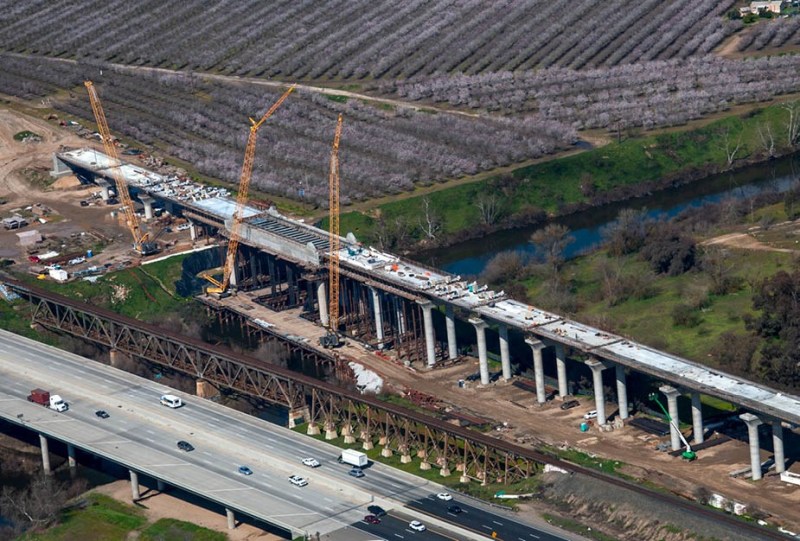Note: Metropolitan Shuttle, a leader in bus shuttle rentals, regularly sponsors coverage on Streetsblog San Francisco and Streetsblog Los Angeles. Unless noted in the story, Metropolitan Shuttle is not consulted for the content or editorial direction of the sponsored content.
The California High-speed Rail Authority (CHSRA) has written two letters to the feds to explain that, despite the erroneous headlines, Governor Gavin Newsom is not halting the state's fast-rail project; heavy construction continues unabated, as seen in the lead image.
After Governor Gavin Newsom's confusing speech on Feb. 12, followed by a raft of false headlines describing the project as "scrapped" or "abandoned," Federal Railroad Administration (FRA) head Ronald Battery informed the state on Feb. 19 that it was going to pull back $929 million that is has already allocated to the "cancelled" train.
From CHSRA CEO Brian Kelly's letter, sent yesterday in response to Battery:
...any "clawback" of federal funds already expended on this project would be disastrous policy. It is hard to imagine how your agency—or the taxpayers—might benefit from partially constructed assets sitting stranded in the Central Valley of California. It is equally difficult to imagine the policy benefit of sending home the more than 2,600 craft workers, men and women who have been dispatched to work on the 119-mile segment now under construction in the Central Valley, one of the nation's most economically distressed regions. Similarly, there is no benefit to sending "stop work" notices to the 488 small businesses, 15 of which are from outside of California, contracted to work on this project. This infrastructure legacy would forever be a travesty.
He also explained that:
...the Governor's approach would expand the initial construction segment selected by the FRA in 2010 to maximize interim ridership and regional connectivity. This is achieved by extending the route to connect urban centers (Merced-Fresno-Bakersfield) and to provide important transit connectivity to the Altamont Corridor Express (ACE) and Amtrak traveling to the Bay Area as well as Sacramento in the north and to bus services traveling from Bakersfield to Los Angeles in the south. A more detailed analysis and implementation plan is forthcoming in the Project Update Report we will submit to the California Legislature on May 1, 2019. The Governor's proposal for high-speed rail's early operations in the Valley would be tangible and transformative for Californians. Importantly, it would not require any additional funding from the federal government. In other words, under our current funding plan, the State, not the federal government, will bear the cost of expansion to downtown Bakersfield and to Merced.
He sent a longer letter to Jammie Rennert, also at the FRA, explaining in more detail how the Authority has complied with the requirements of the grant.
As we reported previously, and as Kelly touches on in his letter, there are already rail connections from the end of the Central Valley segment to San Jose, Oakland, and Sacramento via Amtrak's existing services and the ACE commuter rail service. So, as was always the intention--and indeed, is the state's legal obligation--the 170 mile Central Valley segment will be connected to the rest of California's rail system and therefore useful in itself until the money can be found to finish dedicated high-speed tracks to San Francisco, Los Angeles and beyond.
In an accompanying statement for the media, Kelly wrote that he urged Battery to "...follow a more constructive path" by joining him in "restoring a functional relationship" between the two agencies. "Our mutual goal should be the successful delivery of America’s first truly high-speed rail service."
What will happen next? The CAHSRA has now challenged the FRA's proposal to pull back the grant. If the FRA doesn't change it's tune, it could end up at administrative hearings and, eventually, into court.







